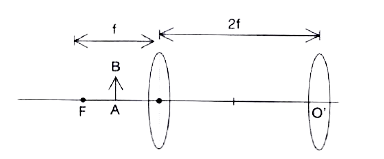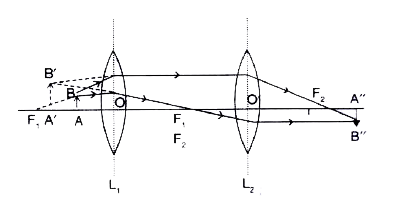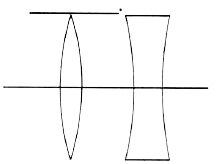An object AB is placed on the principal axis of two lenses of equal focal length (f). The lenses are separated by a distance 2f, as shown in the figure. Using ray diagram locate the image formed by each lens and state their nature.


Let F11 and F12 be the principal foci of the first lens L1, and F21 and F22 be the principal foci of the second lens L2. From the construction of the ray diagram it is evident that two images would be formed, A.B. image formed by the first lens which would become the object for the second lens, and A.B., final image formed by the second lens. A.B. - virtual, erect, on the same side as object AB, and magnified. A"B" - real, inverted, diminished (compared to A.B.) and on the far side of the combination of lens.
Topper's Solved these Questions
- BOOK - PEARSON IIT JEE FOUNDATIONCHAPTER - LIGHTEXERCISE - SOLVED EXAMPLE43videos
LIGHT
- BOOK - PEARSON IIT JEE FOUNDATIONCHAPTER - LIGHTEXERCISE - TRACK YOUR LEARNING - I6videos
LIGHT
- BOOK - PEARSON IIT JEE FOUNDATIONCHAPTER - LIGHTEXERCISE - Concept Application (Level 2)20videos
LIGHT
- BOOK - PEARSON IIT JEE FOUNDATIONCHAPTER - KINEMATICS EXERCISE - CONCEPT APPLICATION (Level 3) (Application Based Questions )5videos
KINEMATICS
- BOOK - PEARSON IIT JEE FOUNDATIONCHAPTER - MAGNETISM EXERCISE - CONCEPT APPLICATION (Level 3)4videos
MAGNETISM
Similar Questions
An object 10 cm tall is placed on the principal axis of a concave lens of focal length 10 cm at a distance of 15 cm from it. Find the position and nature of the image formed by the lens and draw the ray diagram.
View SolutionAn object is placed at a distance of f2 from a convex lens of focal length f. The image will be
View Solution
Knowledge Check
- Question 1 - Select One
An object is placed on the principal axis of a concave mirror at a distance of 1.5 f(f is the focal length). The image will be at,
A1.5fB−1.5fC3fD−3f - Question 2 - Select One
Two convex lenses of focal lengths f1andf2 are separated co-axially by a distance d. The power of the combination will be one if
Ad=(f1+f2)−f1f2Bd=(f1−f2)+f1f2Cd=√f1f2..f1+f2Dd=(f1−f22) - Question 3 - Select One
A convex lens and a concave lens, each of focal length 10 cm, are kept separated by a distance of 2 cm as shown in the figure. If the light is incident from left, the combination of lenses will be :
 AconvergingBdivergingCbehaving like a glass slabDconverging or diverging depending on whether the lenes are arranged as shwon in the figure on in the reverse order.
AconvergingBdivergingCbehaving like a glass slabDconverging or diverging depending on whether the lenes are arranged as shwon in the figure on in the reverse order.
An object is placed at a distance f in front of a concave lens of focal length f. Locate its image.
View SolutionDraw the ray diagram for an object located at 2F for a convex lens and write the nature of image.
View SolutionA 10 cm tall object is placed perpendicular to the principal axis of a convex lens of focal length 12 cm. The distance of the object from the lens is 18 cm. Find the nature, position and size of the image formed.
View SolutionA point object is placed on the optic axis of a convex lens of focal length f at a distance of 2f to the left it. The diameter of the lens d. An eye is placed are distance of 3f to the right of the lens and a distance below the optic axis. The maximum value of h to the image is
View SolutionA point object is placed on the optic axis of a convex lens of focal length f at a distance of 2f to the left of it. the diameter of the lens is 'd' . An eye is placed at a distance of 3f to the right of the lens and a distance h below the optic axis. The maximum value of h to see the image is
View Solution

